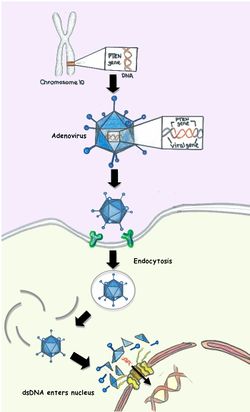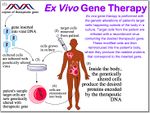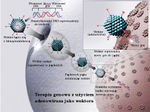Gene therapy
Human Gene Transfer, more commonly known as Gene Therapy, is an experimental technique that is used to treat or prevent a disease with the use of genes. Although gene therapy is a promising treatment option for a number of diseases (including inherited disorders, some types of cancer, and certain viral infections), the technique remains risky and is still under study to make sure that it will be safe and effective. Gene therapy is currently being tested only for diseases that have no other cures. The research that is being done on gene therapy has mainly been focused towards the treatment of individuals who have genetic diseases or disorders.
Genes are considered to be the blueprints for our body. They give the cells the information that is needed to produce proteins and enzymes that control the growth, health, and development of our body. That being said, when a gene in your body has a genetic mutation, there is a disruption to the gene code that causes a faulty gene. Genetic mutations occur either be a spontaneously trait or an inherited trait.
History
Gene therapy was first suggested by researchers in a paper in 1972 to be used to treat genetic diseases. But it was first put into use by Dr. W. French Anderson, who had helped to develop the clinical trial, on September 14, 1990, at the NIH Clinical Center were a four-year old girl, who had adenosine deaminase (ADA) deficiency, became the first patient to receive gene therapy. Adenosine deaminase (ADA) deficiency is a genetic disease that leaves your body defenseless against infections. They took white blood cells from her and inserted the genes that are normally used for making adenosine deaminase into the adenosine deaminase deficient white blood cells. They re-injected the now corrected white blood cells into her.
Dr. W. French Anderson and Dr. Michael Blaese worked together to prove that cells from patients who have adenosine deaminase deficiency can be corrected in tissue culture. To carry the correct human ADA gene to the cells, they used a retrovirus. [1]
Process
The steps to using gene therapy begins with the identification of the faulty gene, then locating the infected cells, then a non faulty version of the gene must be placed into the cell. There are several techniques used to deliver the working gene into the cell. Gene therapy is used to introduce genetic material into cells to compensate for abnormal genes or to make a beneficial protein. If a gene that is mutated causes a faulty or missing protein that is necessary, gene therapy can be used to introduce a normal copy of the mutated gene in order to restore the proper function of the necessary protein.
A gene that is inserted directly into a cell will not function. So they insert the gene with the use of a carrier, also known as a vector, that is genetically engineered to deliver the gene. Sometimes certain viruses can be used as the vector to insert the gene because they can deliver the new gene simply by infecting the cell. These viruses that are used as the vector for the gene are specially modified so that they can't cause any disease when they are used on people. Retroviruses, a type of virus that can be used as the vector, input their genetic material and the new gene into a chromosome that is in the human cell. Unlike retroviruses and those like it, adenoviruses and other like it do not integrate the DNA into a chromosome when they introduce their DNA into the nucleus of the cell. [2]
Uses
Gene therapy can be used to replace a mutated gene with a healthy copy of the gene. It will give doctors the ability to treat patients with various disorders or diseases by inserting a gene into a patient’s cells. Gene therapy is currently available primarily for research uses. The U.S. Food and Drug Administration (FDA) has approved only a limited number of gene therapy products for sale in the United States. There are of clinical trials being done to test the use of gene therapy as a treatment for things like genetic conditions, cancer, and HIV/AIDS. When a person inherits a mutated gene, it can cause a large range of disorders. A couple of the disorders caused by mutated genes are cystic fibrosis and haemophilia. The mutated genes can also cause susceptibility to various cancers. When the genes are used as medicine it is called therapeutic gene therapy. Gene therapy is still an experimental form of treatment for many different genetic diseases and disorders. [3]
Risks
There are several health risks with the use of gene therapy such as toxicity, inflammation, and cancer. One way that Gene therapy can be risky is when viral vectors are used as the carriers to carry the new genes into the body, they could not only infect the intended cell, they could also infect the surrounding healthy cells. The reason why this could happen is because viruses can infect several types of cells. Another possible risk is that the new gene that is being inserted could be mistakenly inserted into the wrong spot in the DNA. If this were to happen it could cause harmful mutations to the DNA. There are also many other risks that could occur with the use of Gene therapy but researchers are working to prevent these problems from occurring as Gene therapy is a very promising solution to genetic diseases and disorders. [1]
Video
Summary of Gene Therapy.
References
- ↑ Unknown. What is gene therapy? yourgenome.org. Web. last-modified May 15, 2018. (specify whether date of publication or last-modified or accessed - i.e. Published November 3, 2015.)
- ↑ Unknown. What is gene therapy? U.S. National Library of Medicine. Web. last-modified May 15, 2018. (specify whether date of publication or last-modified or accessed - i.e. Published November 3, 2015.)
| ||||||||||||||||||||




